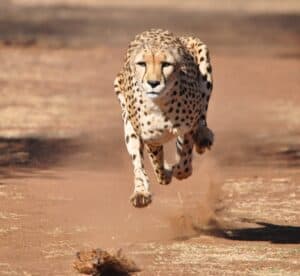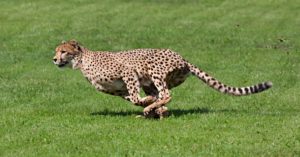Cheetahs are the fastest land animals in the world, but can cheetahs climb trees? Let’s discover whether cheetahs enjoy the lofty heights of tree life or if they’re ground dwellers.
Species Profile: Cheetah
Cheetahs live primarily in the open savannah. They are large cats, bigger than bobcats and servals, but not as large as tigers, lions, or jaguars. Despite their size, they are not classed as big cats because they cannot roar.
Cheetahs are long and slender with black spots on their pale tan bodies. Black tear marks run from their inner eyes, but these marks aren’t decorative; they reduce sun glare and make hunting easier. Their tails are very long, covered in rings, and end with a black tip. Compared to other large cats, they have small heads with high-set eyes and an incredibly flexible spine that adds to their speed and agility.
Cheetahs live throughout Africa and some parts of Asia. They are very fast creatures that reach up to 70 mph in short blasts, so this means they are smaller and lighter than other big cats. They also have nonretractable claws that help them dig into the ground like running spikes!
According to the Guinness World Records, a female cheetah named Sarah set the world record for the fastest land mammal. In 2012, she ran 100 meters from a standing start in 5.95 seconds. During that time, her highest speed was 61 mph. It took Usain Bolt 9.58 seconds to cover the same distance!
An adult cheetah weighs between 80 and 140 lbs compared to a 264 – 55 lbs adult lion. They stand 2-3 feet tall, up to five feet long, and have amazing hearing and scent senses that enable prey tracking from miles away.
Did you know the name cheetah is derived from the Sanskrit Chitra-ya which means ‘painted’ or ‘variegated’? It’s the perfect name for cheetahs with their beautifully adorned coats. No two cheetahs are the same!
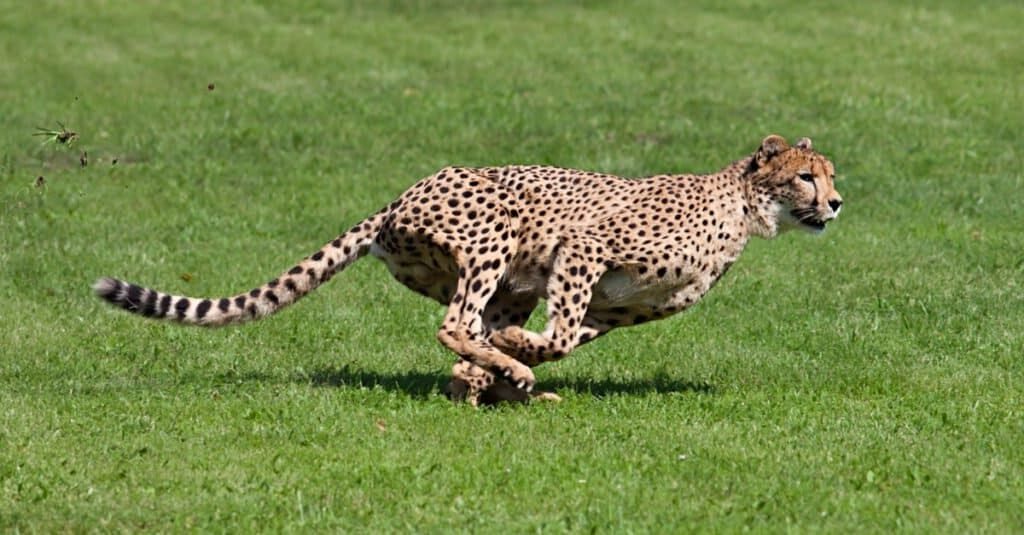
In 2012, Sarah ran 100 meters from a standing start in 5.95 seconds. During that time, her highest speed was 61 mph.
©Maros Bauer/Shutterstock.com
Where Do Cheetahs Live?
Cheetahs live solitary lives throughout Africa and parts of Asia. Their habitats are large home ranges of prairies, grassland, and mountainous terrain.
They once roamed across continents, but today, a small number is scattered in sub-Saharan Africa and Iran.
Cheetahs come together to mate but go their separate ways, with the female raising one to two cubs on her own. On occasion, a small group of adolescent males band together, but females are less likely to accept companionship.
How Many Kinds of Cheetah Are There?
There are five types of cheetahs.
1. Asiatic Cheetah Acinonyx jubatus venaticus
This is the only cheetah remaining in Iran. It has a shorter, denser coat than other cheetah species that’s paler on its sides but darker along its spine. The tail tips are black.
2. South African Cheetah Acinonyx jubatus jubatus
A mid-sized, mid-colored cheetah with tear marks that are wider at the base and a rich brown mustache around its mouth.
3. Northwest African Cheetah Acinonyx jubatus hecki
One of the smallest subspecies, this cheetah has a pale coat with brown and black spots. Some individuals do not have distinctive tear marks.
4. Northeast African Cheetah Acinonyx jubatus fearsoni (or A.j. raineyi)
A large subspecies with a darker coat than other cheetah species, a white stomach, and a thicker tail.
5. East African Cheetah Acinonyx jubatus soemmerringi
A mid-sized cheetah subspecies with pale beige fur, wider tear marks, and a white tail tip. It has coarser fur than its cousins.
What Do Cheetahs Eat?
Cheetahs are most active during daylight hours to avoid competition with other predators that hunt in the cooler evenings and early mornings. Because they are slight, camouflaged, and stealthy solitary hunters, they are more easily able to sneak up on prey and bring it down after a short but intense blast of speed. Cheetahs are so adept at stalking they get within 10-30 meters of their prey before the chase begins.
Prey is almost always killed in obstacle-free open spaces, where the cheetah has outrun it but then dragged to a hiding place away from scavenging lions or hyenas. After capturing its prey, a cheetah needs to rest for at least 30 minutes. Although they are fast, sprinting is hard work.
Cheetahs are obligate carnivores that eat only meat and drink approximately once a week. They mainly hunt antelope, gazelle, zebra, and hares, which are all very fast animals in their own right. In Iran, cheetahs also hunt goats and chinkaras. Cheetahs will kill any meaty prey that is small to mid-sized, including birds.
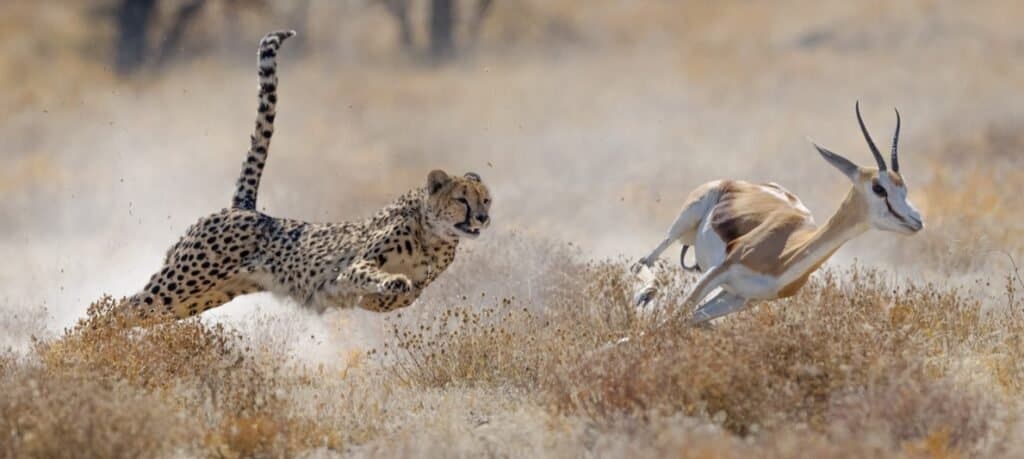
Cheetahs are obligate carnivores that eat only meat and drink approximately once a week. They mainly hunt antelope, gazelle, zebra, and hares.
©Elana Erasmus/Shutterstock.com
Do Cheetahs Have Predators?
Yes, cheetahs have predators if they are able to catch them. However, adult lions, leopards, and hyenas can easily hunt cheetah cubs. Experts estimate only 15% of cheetah cubs make it to adulthood.
Are Cheetahs Able to Climb Trees?
Yes, cheetahs can climb trees. In fact, we learned that cheetahs hide their prey after the chase to avoid scavengers, and up a tree is one of the best places to hide lightweight animals like young fawns, hares, or birds. Cheetahs are not strong enough to drag a large antelope up a tree, so they will try to hide their bigger kills in bushes or grasses instead.
However, cheetahs are not skilled climbers like leopards and tigers because their claws are much smaller, and they don’t retract. This means they can’t grip with their claws as well, but it doesn’t stop them. Cheetahs have incredibly powerful muscles and enough flexibility to climb trees if they want to.
The most suitable tree for a cheetah to climb is the Boscia albitrunca, or shepherd’s tree, that have low-hanging branches and lots of branches in the crown so a cheetah can simply leap from branch to branch without gripping with its claws.
Although they find it hard, gaining altitude is an advantage in the savannah, grasslands, and mountains because it enables predators to get a better view of their surroundings, hide from attackers, and stash food.
Cheetahs also use trees to communicate with others by clawing scent-marked grooves into the bark or urinating on the trunk. Cat experts think this updates the community on which cheetahs are in the vicinity. Male cheetahs are sometimes observed climbing trees and defecating from a height onto their branches and the surrounding ground. Why they do this is not fully understood, but experts suspect it is, so their scent carries further.
Can Cheetah Cubs Climb Trees?
Cheetah cubs like to play and clamber up tree trunks, but they prefer the lower sections near the ground.
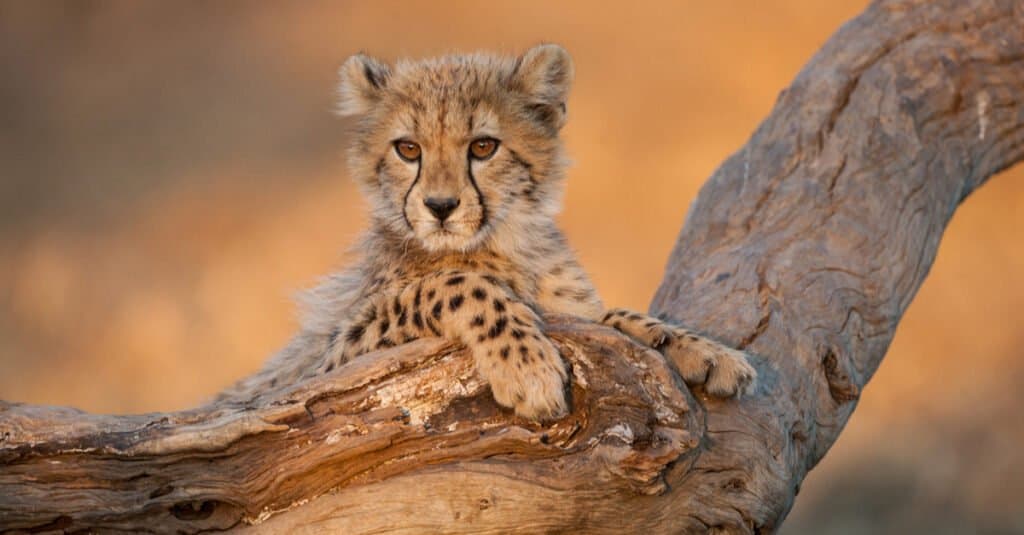
Cheetah cubs like to play and clamber up tree trunks.
©Stu Porter/Shutterstock.com
Are Cheetahs Endangered?
All cheetah species are listed as vulnerable except the northwest African cheetah and the Asiatic cheetah, which are critically endangered. Experts estimate there are only 7,100 left in the world, down from 14,000 in 1975. The Asiatic cheetah is perilously close to extinction, with only 50 or so individuals left in Iran.
Cheetahs are affected by human settlements and habitat degradation. Even though they do not often hunt livestock, farmers poison or shoot them.
Cheetah cubs are endearing, and because the adults are smaller than fully grown lions, they are popular pets in the Middle East. This means cheetah cubs are illegally traded from Africa.
Although there are national parks that offer some security, poachers encroach on them on a regular basis. Another issue is that cheetahs need to roam over a large area, so national parks are just a partial area of territory for them.
Recap: Can Cheetahs Climb Up Trees?
So, to recap our question, can cheetahs climb trees? The answer is yes, cheetahs can climb trees, but they are not natural climbers and find it harder than cats with retractable claws like leopards and lions.
The photo featured at the top of this post is © Kjetil Kolbjornsrud/Shutterstock.com
Thank you for reading! Have some feedback for us? Contact the AZ Animals editorial team.



